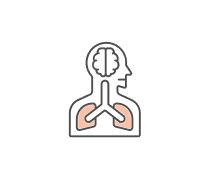This facial bone is the lower jaw bone, and only movable bone of the...
These vertebrae go from C1-C7 and are located in the neck
Another name for C1, which supports the head, is the...
Another name for C2, which serves as a pivot when the head is turned,...
These vertebrae go from T1-T12 and are located in the chest.
These vertebrae go from L1-L5 and are located in the small of the...
The posterior ends of the ribs are attached to the __________...
This is the top portion of the sternum that joins each side of the...
The 5 sacral vertebrae that fuse together in an adult are called...
The tail bone, aka the __________ is made up of 4-5 bones in child...
This is the long, bladelike portion of the sternum that joins with...
The true ribs are the first ___ (#) pairs and attach directly to the...
This is a depression on a bone surface
11 and 12 have no anterior attachment and are called _________...
This is a hole that allows a vessel or a nerve to pass through or...
This is an air space found in some skull bones
This is the lower end of the sternum that consists of a small tip. It...
These vertebrae go from S1-S5 in a child
This projection is rounded, knoblike, and separated from the rest of...
Irregularly shaped bones found in the spinal column are called...
This part of the skull contains 8 bones
This part of the skull contains 14 bones
This bone of the cranium is the forehead bone
The spinal cord enters the cranium through a large hole in the...
These two facial bones fused in midline to form the upper jaw bone. It...
This small, U-shaped bone just below the skull is not attached to any...
The posterior projection of the vertebrae is called the ________...
This projection is a distinct border or ridge
A short channel or passageway is a...
8, 9 and 10 attach to _________ of the rib above
What are the two divisions of the human skeleton?
These bones of the cranium consist of two bones that form part of the...
These two facial bones form the bridge of the nose
This cranial bone is light and fragile, located between the eyes
The smallest bones of the body are the _____ bones
This division of the skeleton is made up of 80 bones that make up the...
This bone forms the back and part of the base of the skull
In the center of each vertebrae there is a large hole called a...
This facial bone consists of two bones that make up the cheek bones
This facial bone forms the lower and back part of the nasal septum
There are ____ (#) ribs that are attached posteriorly to the thoracic...
The three portions of the sternum are...
What are the two parts the skull is divided into?
Name the four curves of the vertebral column
This is a sharp projection from the surface of a bone
This division of the skeleton is made up of 126 bones that form the...
These bones of the cranium consists of two bones that make up the top...
Each one of these bones contains mastoid sinuses as well as the ear...
The bony sheath for the spinal column is called the __________...
This is a large projection of a bone
This cranial bone forms the central part of the floor of the cranium
The three ear bones are the...
The caged shaped structure that protects our lungs and heart is called...
These two facial bones are small and help form the medial wall of the...
These two facial bones form the back part of the hard palate
The drum-shaped body of the vertebrae, that serves as the weight...
The bones of the vertebral column are ___________ and ____________...
The bones of the trunk include the ________ ___________ and the bones...
False ribs are ribs ___ - ___ (#)
Disks of cartilage between the vertebral bodies act as _________...
What are the four projections on bone?
The malleus, incus, and stapes together are called _______
When viewed from the side, the vertebral column can be seen to have a...
What are the four types of depressions or holes?
















